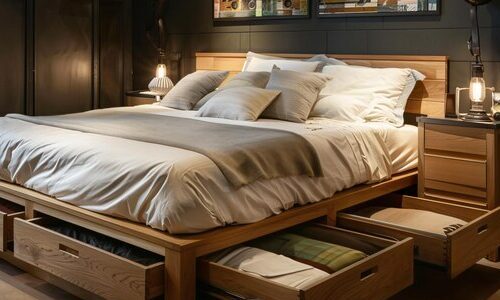
The Durability and Longevity of High-Quality Wooden Beds
When it comes to furniture, few pieces are as essential and central to our daily lives as the bed. A high-quality wooden bed not only offers comfort but also stands the test of time, both in terms of durability and aesthetic appeal. Wooden beds have long been cherished for their timeless beauty and solid construction, providing a sturdy and reliable foundation for restful sleep for generations.
In this blog, we’ll explore what makes high-quality wooden beds so durable, the materials and craftsmanship involved in their creation, and why they continue to be a long-lasting investment for homeowners. We’ll also address the environmental benefits of choosing sustainably sourced wooden beds and the factors that contribute to their longevity.
1. The Strength of Natural Materials
Hardwoods vs. Softwoods: Understanding the Difference
When discussing the durability of wooden beds, it’s important to distinguish between hardwoods and softwoods:
- Hardwoods: These come from deciduous trees (trees that shed their leaves annually) and include species like oak, maple, teak, mahogany, and walnut. Hardwoods are denser and more durable, making them an ideal choice for furniture that is expected to last for decades.
- Softwoods: These come from coniferous trees (trees that remain evergreen) such as pine, cedar, and spruce. While softwoods can also be used to make wooden beds, they are generally less durable than hardwoods. However, softwoods are more affordable and can still be long-lasting when properly maintained.
Why Hardwood Beds Last Longer
The density of hardwood gives it greater resistance to wear and tear. It is less prone to dents, scratches, and other forms of damage compared to softwood. High-quality wooden beds made from hardwood are built to withstand years of use, making them a worthwhile investment for those who prioritize longevity.
- Oak Beds: Oak is one of the most popular materials for wooden beds due to its strength and resistance to moisture. Oak beds can easily last several decades without losing their structural integrity.
- Teak Beds: Known for its natural oils that repel insects and moisture, teak is another excellent choice for durable wooden beds. It is often used in high-humidity environments because of its natural resistance to rot and decay.
2. The Role of Craftsmanship
The durability of a wooden bed is not just about the type of wood used but also the craftsmanship involved in its creation. A well-constructed wooden bed requires precision, skill, and attention to detail to ensure that all joints and components are securely fitted and reinforced.
Traditional Joinery Techniques
One of the key factors contributing to the durability of wooden beds is the use of traditional joinery techniques, which are designed to hold the bed frame together without relying solely on nails or screws. These techniques allow for the natural expansion and contraction of wood over time, ensuring that the bed remains stable and sturdy.
- Mortise and Tenon Joints: This is one of the oldest and strongest joinery techniques used in wooden bed construction. It involves fitting a projecting “tenon” into a corresponding “mortise” cavity. This method creates a tight, strong connection that can bear weight and pressure for many years.
- Dovetail Joints: Frequently used in the construction of wooden bed drawers or storage compartments, dovetail joints provide superior tensile strength. These interlocking joints resist pulling apart, ensuring that drawers or other movable parts of the bed remain intact.
Reinforced Frame Construction
A high-quality wooden bed also features reinforced frames and legs, ensuring the weight of the mattress and sleepers is evenly distributed. Beds that use solid wood slats or a platform for support are more resistant to sagging or bending over time. In contrast, cheaper beds made with particleboard or MDF (medium-density fiberboard) tend to weaken more quickly under regular use.
- Thick Slats or Platform Support: Wooden beds with thick, well-spaced slats or a solid platform base are built to last longer and support heavier loads without bowing or breaking.
3. Longevity Through Proper Maintenance
One of the reasons wooden beds have such impressive longevity is that they can be easily maintained with the right care. Unlike metal or upholstered beds, wood can be repaired, refinished, and restored to look like new, even after years of use.
Regular Cleaning and Polishing
Wooden beds benefit from regular cleaning and polishing to maintain their natural beauty and structural integrity. Dust and dirt can accumulate on the surface of the wood, which can cause minor scratches over time. Polishing the wood with natural oils or wax can also help protect the surface from moisture and prolong the bed’s lifespan.
- Avoiding Moisture: Wooden beds should be kept away from excess moisture, which can cause the wood to warp, swell, or rot. Using coasters, placing mats under water containers, and ensuring that the room has proper ventilation can help prevent water damage.
- Sunlight Exposure: Direct exposure to sunlight can cause wood to fade or dry out. Positioning the bed away from windows or using curtains to block intense sunlight can protect the wood from discoloration.
Repairing and Refinishing
Unlike beds made from composite materials, wooden beds can be refinished multiple times throughout their life. Sanding down the surface, reapplying a protective finish, or repairing small cracks or dents can significantly extend the life of the bed, allowing it to remain functional and aesthetically pleasing for decades.
- Reinforcing Joints: If a bed starts to creak or feel unstable, reinforcing the joints with additional wood glue or replacing worn-out screws can restore the bed’s stability.

4. Sustainability and Eco-Friendly Choices
In today’s environmentally conscious world, the sustainability of the materials used in furniture is becoming increasingly important. High-quality wooden beds made from sustainably sourced timber offer not only durability but also an eco-friendly option for homeowners looking to reduce their carbon footprint.
Certified Sustainable Wood
Many furniture manufacturers now use wood that is certified by organizations such as the Forest Stewardship Council (FSC). This ensures that the wood has been sourced from responsibly managed forests, where trees are replanted, and ecosystems are protected.
- Long-Term Investment: Choosing a high-quality wooden bed made from sustainably sourced wood is an investment not only in your home but also in the environment. These beds are built to last, reducing the need for replacement and minimizing the environmental impact of disposable furniture.
5. Timeless Aesthetic Appeal
Beyond their functional benefits, wooden beds have a timeless aesthetic appeal that can complement any interior design style, from rustic to contemporary. The natural beauty of wood, with its unique grain patterns and warm tones, adds a sense of warmth and character to a bedroom.
Classic Designs That Last
High-quality wooden beds are often crafted in classic designs that transcend passing trends. Whether you prefer the ornate carvings of a traditional four-poster bed or the clean lines of a minimalist platform bed, a wooden bed can effortlessly blend into your bedroom’s décor and remain stylish for years to come.
6. The Cost vs. Longevity Factor
While high-quality wooden beds tend to be more expensive than beds made from composite materials or softwoods, their longevity justifies the investment. A well-made wooden bed can last for decades, if not generations, whereas cheaper alternatives may need to be replaced after just a few years.
- Value Over Time: When you consider the cost of replacing a lower-quality bed every few years, investing in a high-quality wooden bed actually saves money in the long run. The durability of hardwood ensures that you won’t have to worry about your bed breaking down or becoming unstable over time.
FAQs
1. What type of wood is best for a durable wooden bed?
Hardwood types like oak, teak, walnut, and mahogany are highly durable and resistant to wear, making them ideal for long-lasting wooden beds.
2. How can I prevent my wooden bed from getting scratched?
To minimize scratches, avoid placing heavy or sharp objects directly on the wood. Applying protective wax or oil periodically and using coasters can help prevent minor abrasions.
3. Do wooden beds require a lot of maintenance?
Wooden beds are relatively low-maintenance. Regular dusting and occasional polishing are usually sufficient. For long-term care, applying wax or oil every few years can help maintain its finish.
4. Are wooden beds eco-friendly?
Yes, wooden beds made from sustainably sourced or reclaimed wood are eco-friendly. By choosing FSC-certified wood or recycled materials, you’re contributing to responsible forest management.
5. Can wooden beds withstand humid environments?
While wooden beds can handle some moisture, high humidity can lead to warping or swelling over time. To prevent this, keep your bed in a temperature-controlled room or use a dehumidifier if necessary.
Conclusion
High-quality wooden beds have an enduring appeal that goes beyond simple functionality. Their durability, combined with a timeless aesthetic, makes them a worthwhile investment for any bedroom. With proper care, a well-made wooden bed can last for decades, providing comfort, elegance, and a unique sense of warmth to any home.
The benefits of durability, ease of maintenance, customization, and environmental friendliness underscore why wooden beds remain one of the best choices for homeowners today. By choosing a high-quality wooden bed, you’re not only making a practical investment but also bringing a piece of nature and craftsmanship into your home, creating a space that’s both restful and inspiring.

